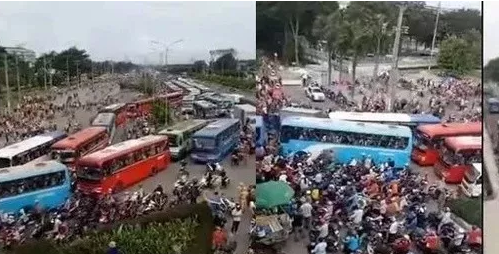
Let's first take a look at Vietnam's sustained economic growth in recent years and its close cooperation with various trading partners. In particular, the development of footwear is booming, and the export of footwear products shows a strong growth trend.
Current situation of footwear industry in Vietnam
Statistics show that in 2014, Vietnam's footwear exports exceeded 11 billion US dollars, with 40 countries and regions exporting. Among them, exports to the United States reached US $3.33 billion, a year-on-year increase of 26.7%; exports to Belgium reached US $659 million, a year-
on-year increase of 27.7%; exports to Germany reached US $600 million, a year-on-year increase of 31.2%; exports to the United Kingdom reached US $573 million, a year-on-year increase of 5.4%; exports to Japan reached US $521 million, a year-on-year increase of 33.8%; exports to China reached US $505 million, a year-on-year increase of 42. At present, 812 enterprises in Vietnam are involved in shoemaking, luggage and other business fields, including 516 shoemaking enterprises, 33 leather enterprises and 263 luggage production enterprises.
In terms of regional distribution, Vietnam's footwear production is mainly distributed in three major cities in Vietnam: Ho Chi Minh City, Hanoi, the capital, and Haiphong city. Ho Chi Minh's shoes factory is mainly engaged in middle and high-end leather shoes, while Hanoi, the capital city, produces mostly vulcanized shoes. As for Haiphong City, there are some larger shoe processing factories.
Ye Chengjie, vice president of the Vietnam leather and luggage Association (Lefaso), said that as the world's fourth largest footwear supplier, the footwear industry has become the third largest export industry in Vietnam, second only to coal and rubber. The main export markets of Vietnam's footwear products are the United States and the European Union, and the main export products are high-grade leather shoes and sports shoes.
It is worth noting that Vietnam exported $505 million of footwear to China last year, an increase of 42.2% year on year, ranking sixth in the total export volume. Since the launch of China ASEAN Free Trade Area in 2010, all the shoes brands exported from ASEAN to China have achieved zero tariff. Not only the export orders of Chinese shoes enterprises have been diverted by Vietnam and other Southeast Asian countries, but also the domestic market has been gradually "nibbled" by Southeast Asian shoes industry.
In particular, the Ministry of industry and trade of Vietnam formulated the overall development plan of Vietnam's footwear industry for 2025 by 2020, which proposes to build the footwear industry into a pillar export industry of the national economy by 2020. By 2020, the annual production of footwear products is 17 billion pairs, 300 million bags, and more than 1 million employment opportunities.
Development advantages of Vietnam's footwear industry
1. Low labor cost
It has been compared that the monthly salary of workers in the eastern coastal areas of mainland China is about $500-600, while that in Vietnam is only about $250. Cheap labor advantage is helping Vietnam, with a population of 90 million, open a "world factory".
2. International environment: GSP preferential tariff rate
Vietnam enjoys a number of preferential policies in exporting to the United States, the European Union and ASEAN, which is one of the countries less affected by international trade restrictions and anti-dumping at present, especially to the United States and the European Union. Vietnam has been enjoying preferential tariff rate of footwear GSP for a long time, which has also become an important reason for attracting many investors in Vietnam.
3. Geographical advantages
Vietnam is one of the countries with the best economic and natural conditions in the world. Compared with other countries in Southeast Asia, Vietnam is a long country with a coastline of 3260 kilometers, which provides a natural geographical advantage for its development of foreign trade and economic cooperation. Secondly, nearly one third of Vietnam's land is plain, with convenient transportation.
4. Government policy guidance
In order to speed up the pace of reform and opening up, the Ministry of industry and trade of Vietnam has issued the guidance plan for industrial development before 2020 and the vision for 2030, a plan approved by the Prime Minister of Vietnam, in which textile, clothing and shoemaking will be included in one of the key development pillar industries of Vietnam in the next stage.
I've seen some of them, but I always think you have any misunderstanding about Vietnam market? Vietnam's economic situation is really good at present, but after reading those articles, it gives people the illusion that as long as they complete the formalities in spring and throw money to Vietnam, they can take sacks to hold money in autumn. How could there be such a good thing in the world? The truth is that it's very hard to do manufacturing. It's very hard in China or Vietnam. You have to carefully calculate the cost of each link and do a good job in production, supply and marketing. But this is only the premise. It depends on luck whether you can make money in the end.
In the field of primary manufacturing, in my years of experience, cost is the first element, and labor cost is the core element of all costs.
In the shoes industry, unless you are global exclusive, price reduction is the general trend. The high-end manufacturing industry has the threshold of R & D cost, and sometimes it can carry it. The technology content of the primary footwear manufacturing industry is very small, which is piled up by human cost, so the cost advantage is almost your only advantage. Price war is the only tactic in the primary manufacturing industry. Everything we do every day, whether it's cost control, equipment improvement, strengthening management and improving efficiency, is ultimately to gain more chips in the price war, which often determines the life and death of the factory.
Rising labor costs usually mean that all costs are rising in an all-round way.
Before and after 2005, when I opened a shoe factory in Dongguan, I obviously felt more and more pressure to survive. At that time, the actual monthly income of front-line workers was generally about 3000-4500 yuan (including overtime), which was still the case of food and accommodation, but even so, I couldn't recruit skilled manual workers.
Around 2008, the monthly income of front-line workers rose to 4000-6000 yuan, which is still difficult to recruit skilled workers. The cost has risen so much all of a sudden, and at the same time, the foreign trade orders have also been sharply reduced. Once the two sides hit each other, they could not go on.
A lot of people say that it doesn't look like a big increase in labor. But our industry is a labor-intensive enterprise. There are hundreds of thousands of employees in small factories and tens of thousands of employees in large factories. With such a large per capita increase, the cost will rise horribly.
Now in Vietnam, the average worker's monthly salary is about 1600 yuan, so the pressure on the labor cost in manufacturing is really much lighter. In addition to the tax relief policy of the Vietnamese government, it's still very good.
Vietnam's shoes industry should follow the local custom
In terms of investing in shoes industry in Vietnam, the media has said a lot now, such as cheap labor, strong tax relief and so on, which are all true. But since you asked me to talk about dry goods, I would like to say something about other aspects rarely mentioned by the domestic media.
First of all, Vietnam's market is not only hot this year, nor only the Chinese are paying attention to investment opportunities in Vietnam. In fact, investment here is directly international competition. Don't think Vietnam is a new continent just discovered by you. If you think like that, you think wrong from the beginning.
To be honest, I have deeply realized in these years that Japanese enterprises are indeed several grades better than Chinese enterprises in terms of management, and they may be the best in terms of details in the world.
European and American enterprises are also much better than Chinese enterprises in standardized management, and they are leading in technology improvement. But in Europe, America, Japan and South Korea, we have a common idea. Our Chinese enterprises are flexible, flexible, decisive and flexible, so we have our advantages.
Every time I return home, I am asked about Vietnam investment. Many people read the articles in the media and think that Vietnam's economic foundation is weak. When they come here, they can bring the domestic industrial experience to the "dimension reduction attack". In fact, they think this is wrong. We are not here to compete with Vietnamese natives, but with people from all over the world. There are enterprises from Europe and the United States, from Japan and South Korea. Do you think the idea of "dimension reduction attack" can be established?
Secondly, to invest here, we must "do as the Romans do".
When I say "do as the Romans do", you may think I'm talking about local customs, traditional festivals, religious beliefs, etc. in fact, it's not just these aspects. What I mean by "do as the Romans" is a broad concept. This one seems easy, but it's very difficult to do well.


Another "custom" that must be followed is the living habits of the local people. For example, Vietnamese don't like living in dormitories, and they have to go home later, so they don't have to worry about the dormitories in the factory.

This is also a key consideration for primary manufacturing. Why did China's reform and opening up begin along the coast? In fact, it's also because of the low cost of sea transportation. If it's all land transportation, China's cost advantage in international competition is not much. The ex factory price of a pair of shoes is only tens of yuan. If the logistics cost accounts for a high proportion, then the business cannot be done.
There are also successful migration of labor-intensive enterprises to the central and western regions, such as Foxconn.
I sometimes read domestic information. There are rumors about Foxconn's relocation, but it has not gone. I think it is mainly due to industry differences. When Foxconn makes mobile phones, the value of goods in IT industry is higher than that of shoes, so the pressure of land transportation cost may still be bearable. They also do OEM of Apple mobile phones. How expensive Apple mobile phones are, we can't match them at all. In addition, Foxconn can replace people with machines and reduce labor costs, but it can't replace people with machines in shoes making. Labor is still the main productivity of the industry.
It manufacturing is a technology, while shoes manufacturing is a technology, which is fundamentally different, so shoes manufacturing come to Vietnam, but Foxconn doesn't have to come.
I mean, if someone wants to invest in Vietnam and set up a factory after reading this article, they should first consider their own industry characteristics. Some industries are suitable and some are not. At present, Vietnam is suitable for labor-intensive enterprises, but not for high-tech enterprises.
Vietnam's population seems to be over 100 million now. There is a population base and the fertility rate is not low. This is the basic capital for its rise. Many countries in Southeast Asia do not have such a population base. I feel that Vietnamese are diligent and able to endure hardships, as was the case with Chinese 20 years ago. Especially the Vietnamese women workers, they really work hard. If you go to Vietnam for tourism, you will find that the small vendors are basically women. With a population and diligence, such a nation can always find its own way to survive in this world.

However, Vietnam also has its own problems. For example, there are a lot of young workers in Vietnam, but their education level is low, so there is no shortage of people to work hard, but they can't do creative work. So Vietnam's current situation is only suitable for labor-intensive and low-tech industries.
But from another perspective, in a few years' time, industries like the Internet will have great potential in Vietnam. Vietnam has a large number of young people and a clear sense of vitality, while China's population structure is gradually aging, which is not the same on both sides. But I don't understand the Internet industry. It's hard to say whether it's suitable or not.
Our main products: cutting machine, digital cutting machine, midsole slitting machine, midsole laminating machine, shoe material cutter, midsole cutting machine, outsole cutting machine, Gangbao cutting machine, leather sole cutting machine
Hotline: 0769-85582246 / 139 2924 6869